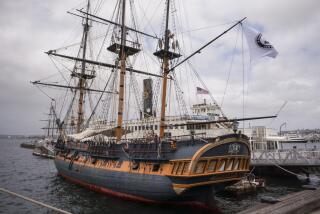WESTMINSTER : Students on Pilgrim Voyage Back in Time
- Share via
Standing aboard the wind-swept deck of the Pilgrim, a replica of a 19th-Century ship, the young sailors snapped to attention Tuesday afternoon as the surly first mate demonstrated the proper way to coil a rope.
“Clockwise! That’s not clockwise,” Bill Dempsey, the first mate, growled as he instructed his crew on how sailors did their jobs 160 years ago.
Dempsey’s 29 crew members, all fifth-grade students from Clegg Elementary School in Westminster, boarded the ship Pilgrim as part of a “living history” lesson offered by the Orange County Marine Institute in Dana Point. The 18-hour adventure, which ends this morning, is part of a program aimed at teaching students about history through role playing. During their stay on the Pilgrim, a brig, with two square-rigged masts, students had to remain in character. They played sailors living on a ship traveling in 1834 from Boston to what is now Dana Point.
Dempsey, 42, an instructor for the institute, took on the role as the ship’s first mate and disciplinarian, responsible for making sure the crew members did their jobs to perfection. As part of his role-playing, he alternately instructed, berated and praised everyone on board, including students, parents, teachers and institute workers, all of whom were assigned roles to play.
“What I expect from your lips is, ‘Aye aye, Mr. Dempsey,’ ” the first mate told the sailors when they arrived. “You will never address me as ‘sir.’ There is only one sir on the brig and that is the captain. It is not possible to say ‘sir’ to the captain too many times.”
Throughout the afternoon, Dempsey addressed the group as “men” or “lads,” and pointed out that there were no female sailors back in the 1800s because women on ships were considered bad luck.
“Step lively, lads! Get the anchors out of your pants,” he roared when the sailors moved too slowly.
To the grog-befuddled second mate, played by program coordinator, Ross Klingsberg, 27, Dempsey shouted, “My 92-year-old dead granny with a wooden leg who’s 4-foot-2-inches tall can move faster than you.”
The speech prompted some giggles, which Dempsey quickly quelled with renewed orders for the sailors to get moving.
In keeping with the setting, students and teachers were prohibited from wearing watches or sunglasses because such items were not worn by sailors of that period.
Karin de Anda, one of the institute’s program coordinators, said that students “really learn about history. They learn about the harsh life in the 1830s, and it makes them appreciate the lives they have.”
As sea gulls soared lazily between the brig’s two masts, the crew toiled all afternoon and into the night. Some students formed a landing party that rowed a longboat to shore. Others chopped potatoes and carrots to make a stew for dinner.
“It’s really nice to be here and spend the night and see a real boat like this that they used to sail a long time ago,” said Jerry Miller, 10. “I think this would be great for all kids everywhere at every school. It’s fun in a kid’s mind, and the person will remember because they had a good time.” As he coiled an inch-thick rope that hung from one of the masts, Jerry added that although it was fun, “it seems hard to do all this work.”
The best part is “you get to live it,” said Devon Grosch, 10, who added that she had been so excited by the prospect of the adventure that she dreamed about it. “It’s a fun experience.”
More to Read
Sign up for The Wild
We’ll help you find the best places to hike, bike and run, as well as the perfect silent spots for meditation and yoga.
You may occasionally receive promotional content from the Los Angeles Times.





